Wideband Multi-Layered Dielectric Resonator Antenna with Small Form Factor for 5G Millimeter-Wave Mobile Applications
Abstract
1. Introduction
2. Antenna Element Design and Simulations
2.1. Antenna Configuration and Simulation
2.2. Analysis of RDRA Resonant Modes
2.3. Parametric Studies on CFPL-ML-RDRA
3. Antenna Fabrication and Measured Results
4. 1 × 4 Antenna Array Performance Simulation
5. Conclusions
Author Contributions
Funding
Institutional Review Board Statement
Data Availability Statement
Acknowledgments
Conflicts of Interest
References
- Saeidi, T.; Saleh, S.; Timmons, N.; McDaid, C.; Al-Gburi, A.J.A.; Razzaz, F.; Karamzadeh, S. High-gain miniaturized multi-band MIMO SSPP LWA for vehicular communications. Technologies 2025, 13, 66. [Google Scholar] [CrossRef]
- Lee, W.; Won, H.; Hong, Y.K.; Choi, M.; An, S.Y. Wideband patch antenna with modifield L-probe feeding for mmWave 5G mobile applications. Electronics 2024, 13, 3119. [Google Scholar] [CrossRef]
- An, S.Y.; Kim, B. Smallest form-factor multi-stacked ceramic patch antenna on package for 5G millimeter-wave mobile applications. Photonics Nanostruct.-Fundam. Appl. 2023, 57, 101189. [Google Scholar] [CrossRef]
- Hong, W.; Jiang, Z.H.; Yu, C.; Zhou, J.; Chen, P.; Yu, Z.; Yang, B.; Pang, X.; Jiang, M.; Cheng, Y.; et al. Multibeam antenna technologies for 5G wireless communications. IEEE Trans. Antennas Propag. 2017, 65, 6231–6249. [Google Scholar] [CrossRef]
- Liu, D.; Gu, X.; Baks, C.W.; Valdes-Garcia, A. Antenna-in-package design considerations for Ka-band 5G communication applications. IEEE Trans. Antennas Propag. 2017, 65, 6372–6379. [Google Scholar] [CrossRef]
- Lin, X. 3GPP evolution from 5G to 6G: A 10-year retrospective. Telecom 2025, 6, 32. [Google Scholar] [CrossRef]
- Keyrouz, S.; Caratelli, D. Dielectric resonator antennas: Basic concepts, design guidelines, and recent developments at millimeter-wave frequencies. Int. J. Antennas Propag. 2016, 2016, 6075680. [Google Scholar] [CrossRef]
- Mishra, P.K.; Jahagirdar, D.R.; Kumar, G. A review of broadband dual linearly polarized microstrip antenna design with high isolation. IEEE Antennas Propag. Mag. 2014, 56, 238–251. [Google Scholar] [CrossRef]
- Petosa, A.; Ittipiboon, A. Dielectric resonator antennas: A historical review and the current state of the art. IEEE Antennas Propag. Mag. 2010, 52, 91–116. [Google Scholar] [CrossRef]
- Pan, Y.M.; Yu, X.Q.; Zheng, S.Y. A simple decoupling method for 5G millimeter-wave MIMO dielectric resonator antennas. IEEE Trans. Antennas Propag. 2019, 67, 2224–2234. [Google Scholar] [CrossRef]
- Petosa, A.; Thirakoune, S. Rectangular dielectric resonator antennas with enhanced gain. IEEE Trans. Antennas Propag. 2011, 59, 1385–1389. [Google Scholar] [CrossRef]
- Chair, R.; Kishk, A.A.; Lee, K.F. Experimental investigation for wideband perforated dielectric resonator antenna. Electron. Lett. 2006, 42, 137–139. [Google Scholar] [CrossRef]
- Fang, X.S.; Shi, K.P.; Sun, Y.X. Design of the single-/dual-port wideband differential dielectric resonator antenna using higher order mode. IEEE Antennas Wirel. Propag. Lett. 2020, 19, 1605–1609. [Google Scholar] [CrossRef]
- Gupta, R.D.; Parihar, M.S. Differentially fed wideband rectangular DRA with high gain using short horn. IEEE Antennas Wirel. Propag. Lett. 2017, 16, 1804–1807. [Google Scholar] [CrossRef]
- Perron, A.; Denidni, T.A.; Sebak, A.-R. High-gain hybrid dielectric resonator antenna for millimeter-wave applications: Design and implementation. IEEE Trans. Antennas Propag. 2009, 57, 2882–2892. [Google Scholar] [CrossRef]
- Guha, D.; Antar, Y.M.M.; Ittipiboon, A.; Petosa, A.; Lee, D. Improved design guidelines for the ultra wideband monopole-dielectric resonator antenna. IEEE Antennas Wirel. Propag. Lett. 2006, 5, 373–376. [Google Scholar] [CrossRef]
- Guha, D.; Gupta, B.; Antar, Y.M.M. Hybrid monopole-DRAs using hemispherical/conical-shaped dielectric resonators: Improved ultrawideband designs. IEEE Trans. Antennas Propag. 2012, 60, 393–398. [Google Scholar] [CrossRef]
- Gao, Y.; Popov, A.P.; Ooi, B.L.; Leong, M.S. Experimental study of wideband hybrid dielectric resonator antenna on small ground plane. Electron. Lett. 2006, 42, 731–733. [Google Scholar] [CrossRef]
- Lin, Y.-F.; Chen, H.-M.; Lin, C.-H. Compact dual-band hybrid dielectric resonator antenna with radiating slot. IEEE Antennas Wirel. Propag. Lett. 2009, 8, 6–9. [Google Scholar]
- Hong, W.; Baek, K.H.; Ko, S. Millimeter-wave 5G antennas for smartphones: Overview and experimental demonstration. IEEE Trans. Antennas Propag. 2017, 65, 6250–6261. [Google Scholar] [CrossRef]
- Guha, D.; Gajera, H.; Kumar, C. Cross-polarized radiation in a cylindrical dielectric resonator antenna: Identification of source, experimental proof, and its suppression. IEEE Trans. Antennas Propag. 2015, 63, 1863–1867. [Google Scholar] [CrossRef]
- Guha, D.; Gajera, H.; Kumar, C. Perturbation technique to improve purity of modal fields in dielectric resonator antenna resulting in reduced cross-polarized radiation. IEEE Trans. Antennas Propag. 2015, 63, 3253–3257. [Google Scholar] [CrossRef]
- Mongia, R.K.; Ittibipoon, A.; Cuhaci, M. Low profile dielectric resonator antennas using a very high permittivity material. Electron. Lett. 1994, 30, 1362–1363. [Google Scholar] [CrossRef]
- Li, B.; Leung, K.W. Strip-fed rectangular dielectric resonator antennas with/without a parasitic patch. IEEE Trans. Antennas Propag. 2005, 53, 2200–2207. [Google Scholar]
- Li, Y.; Zhang, Z.; Chen, W.; Feng, Z.; Iskander, M.F. A dual-polarization slot antenna using a compact CPW feeding structure. IEEE Antennas Wirel. Propag. Lett. 2010, 9, 191–194. [Google Scholar] [CrossRef]
- Lee, W.; Hong, Y.-K.; Lee, J.; Gillespie, D.; Ricks, K.G.; Hu, F.; Abu-Qahouq, J. Dual-polarized hexaferrite antenna for unmanned aerial vehicle (UAV) applications. IEEE Antennas Wirel. Propag. Lett. 2013, 12, 765–768. [Google Scholar] [CrossRef]
- Lier, E.; Jakobsen, K.R. Rectangular microstrip patch antennas with infinite and finite ground plane dimensions. IEEE Trans. Antennas Propag. 1983, 31, 978–984. [Google Scholar] [CrossRef]
- Nguyen, M.T.; Kim, B.; Choo, H.; Park, I. Effects of ground plane size on a square microstrip patch antenna designed on a low-permittivity substrate with an air gap. In Proceedings of the 2010 International Workshop on Antenna Technology (iWAT), Lisbon, Portugal, 1–3 March 2010; pp. 1–4. [Google Scholar]
- Rai, H.T.; Mu, G.W.; Lu, R.Q. Integrated Dielectric Resonator Antenna to Traditional Antenna for Better Bandwidth and Gain. Natl. J. Antennas Propag. 2024, 6, 9–16. [Google Scholar]
- Bizan, M.S.; Naseri, H.; Pourmohammadi, P.; Melouki, N.; Iqbal, A.; Denidni, T.A. Dual-Band Dielectric Resonator Antenna with Filtering Features for Microwave and Mm-Wave Applications. Micromachines 2023, 14, 1236. [Google Scholar] [CrossRef]
- Tirado-Méndez, J.A.; Jardón-Aguilar, H.; Linares-Miranda, R.; Flores-Leal, R.; Vasquez-Toledo, A.; Gomez-Villanueva, R.; Perez-Miguel, A. Compact Four-Port Axial Symmetry UWB MIMO Antenna Array with Bandwidth Enhancement Using Reactive Stub Loading. Symmetry 2025, 17, 1285. [Google Scholar] [CrossRef]
- Cepeda, L.E.; Garza, L.A.; Panduro, M.A.; Reyna, A.; Zuñiga, M.A. Thinned Eisenstein Fractal Antenna Array Using Multi-Objective Optimization for Wideband Performance. Appl. Sci. 2025, 15, 5584. [Google Scholar] [CrossRef]
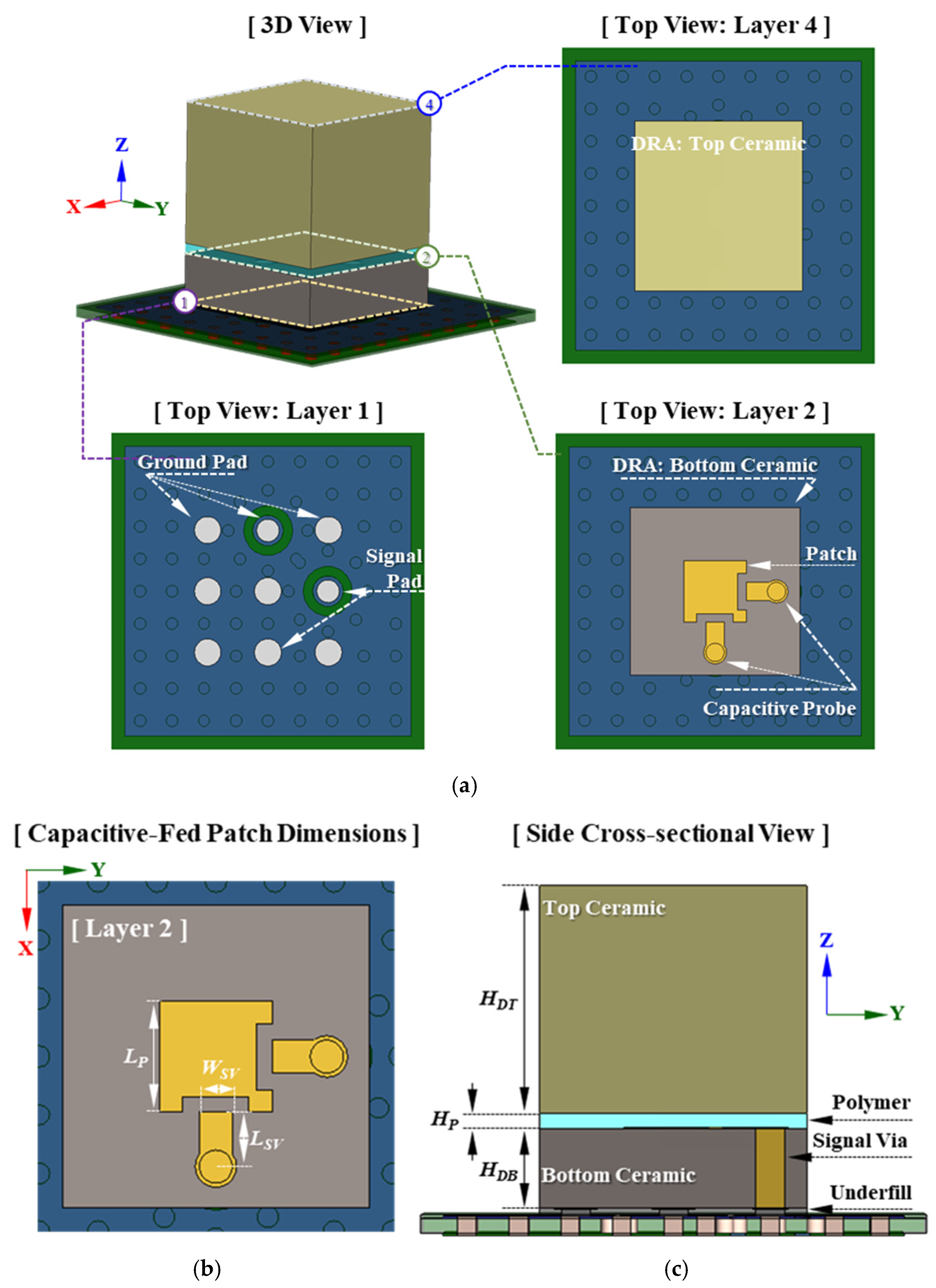

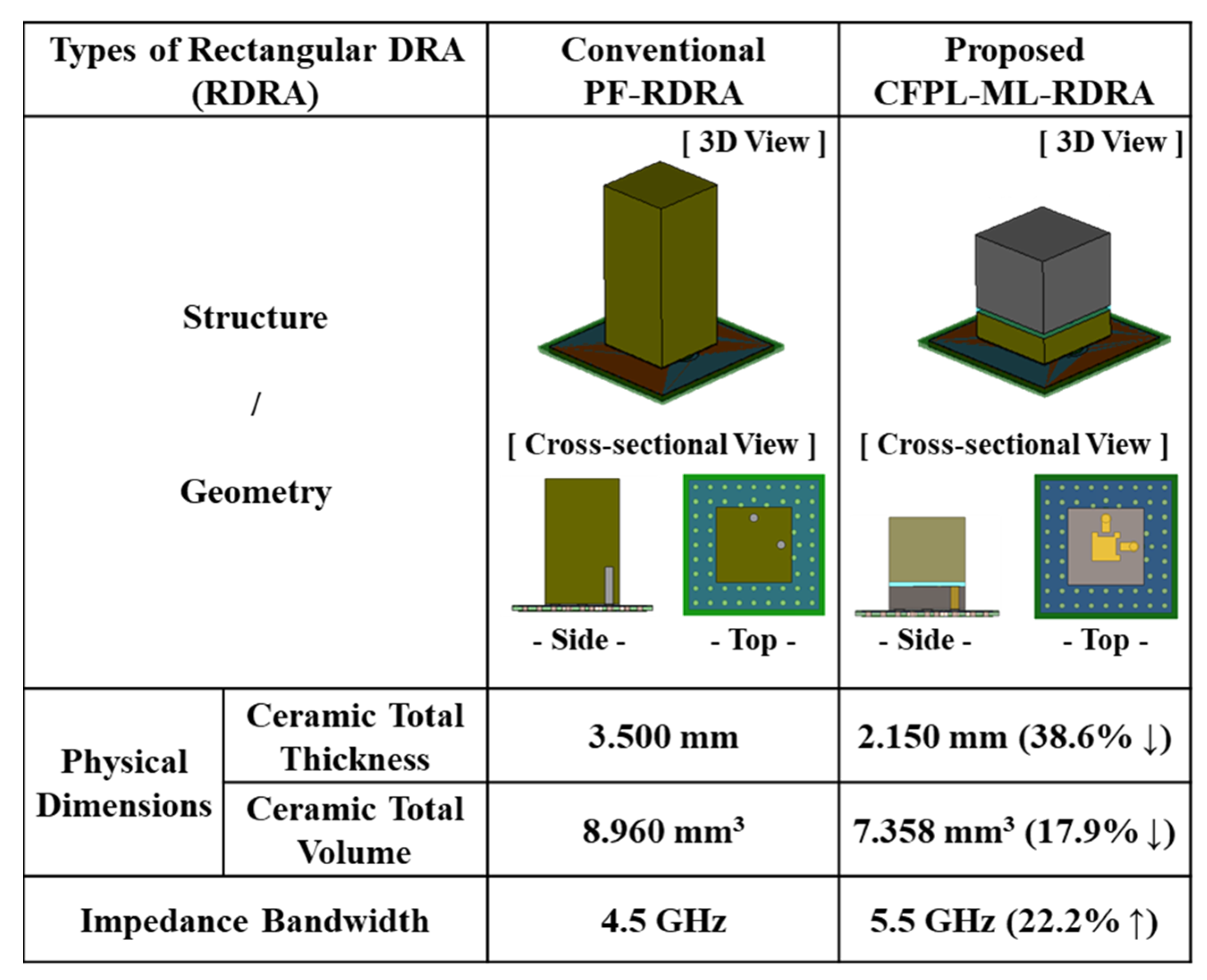

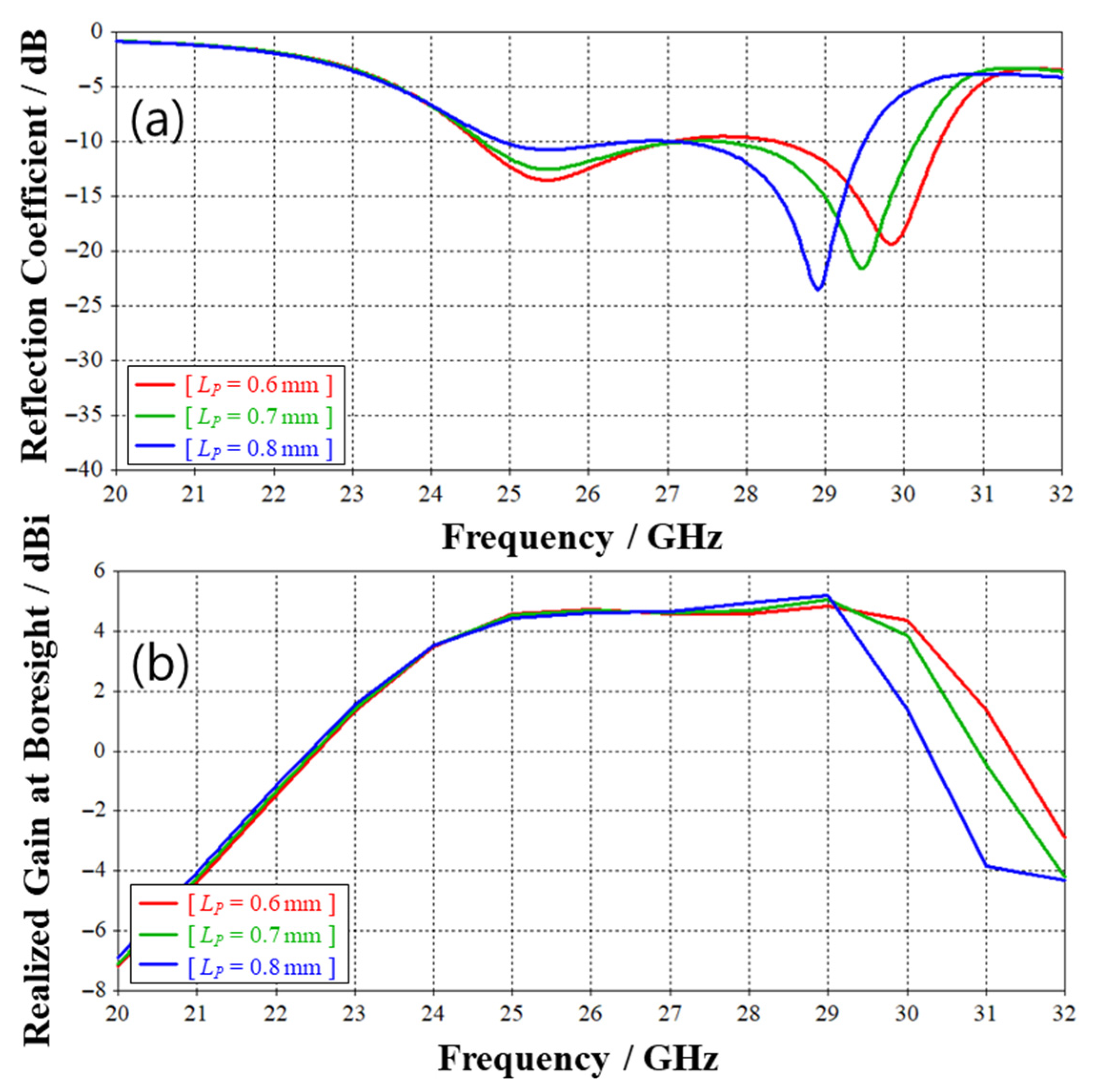
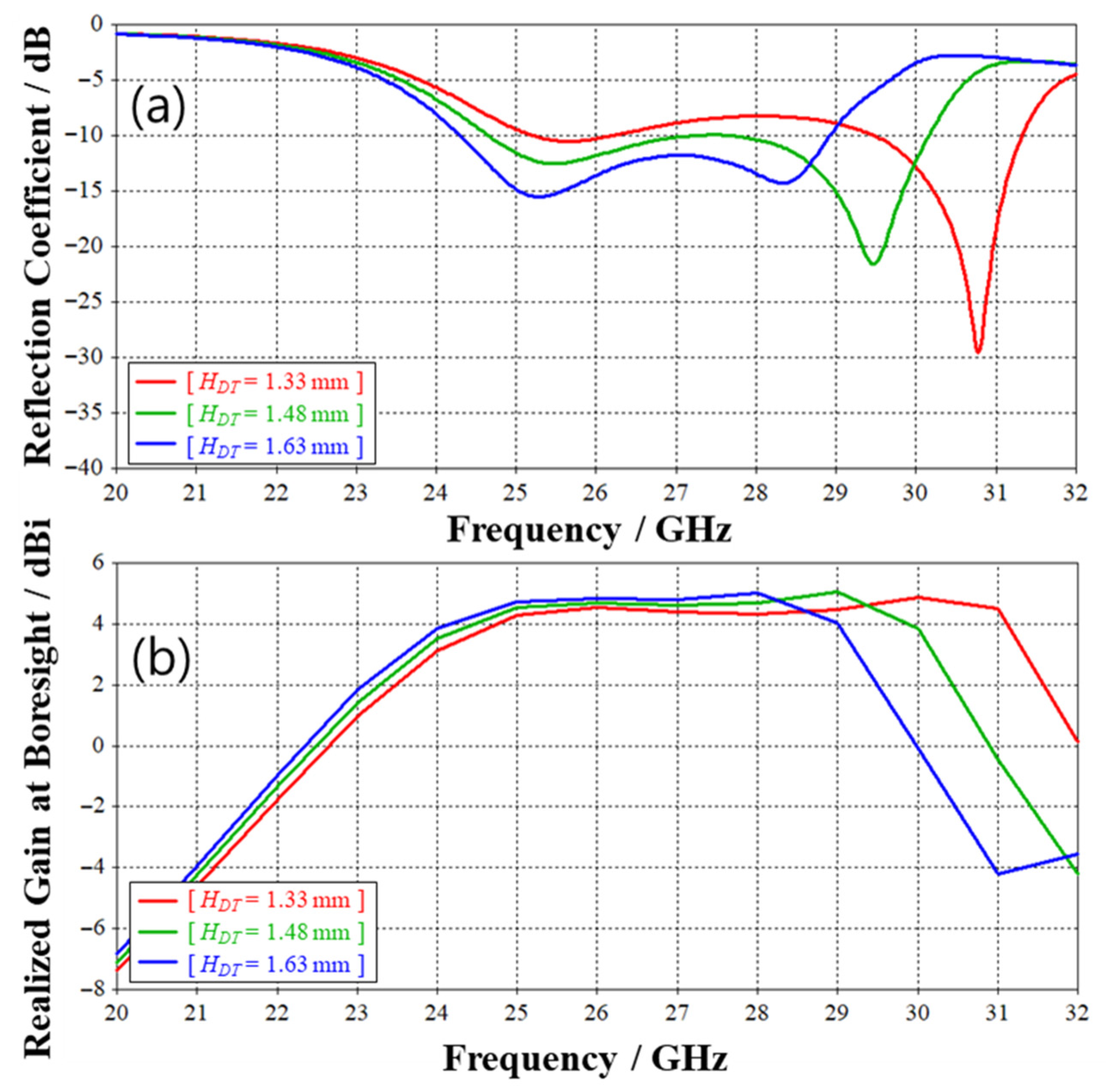


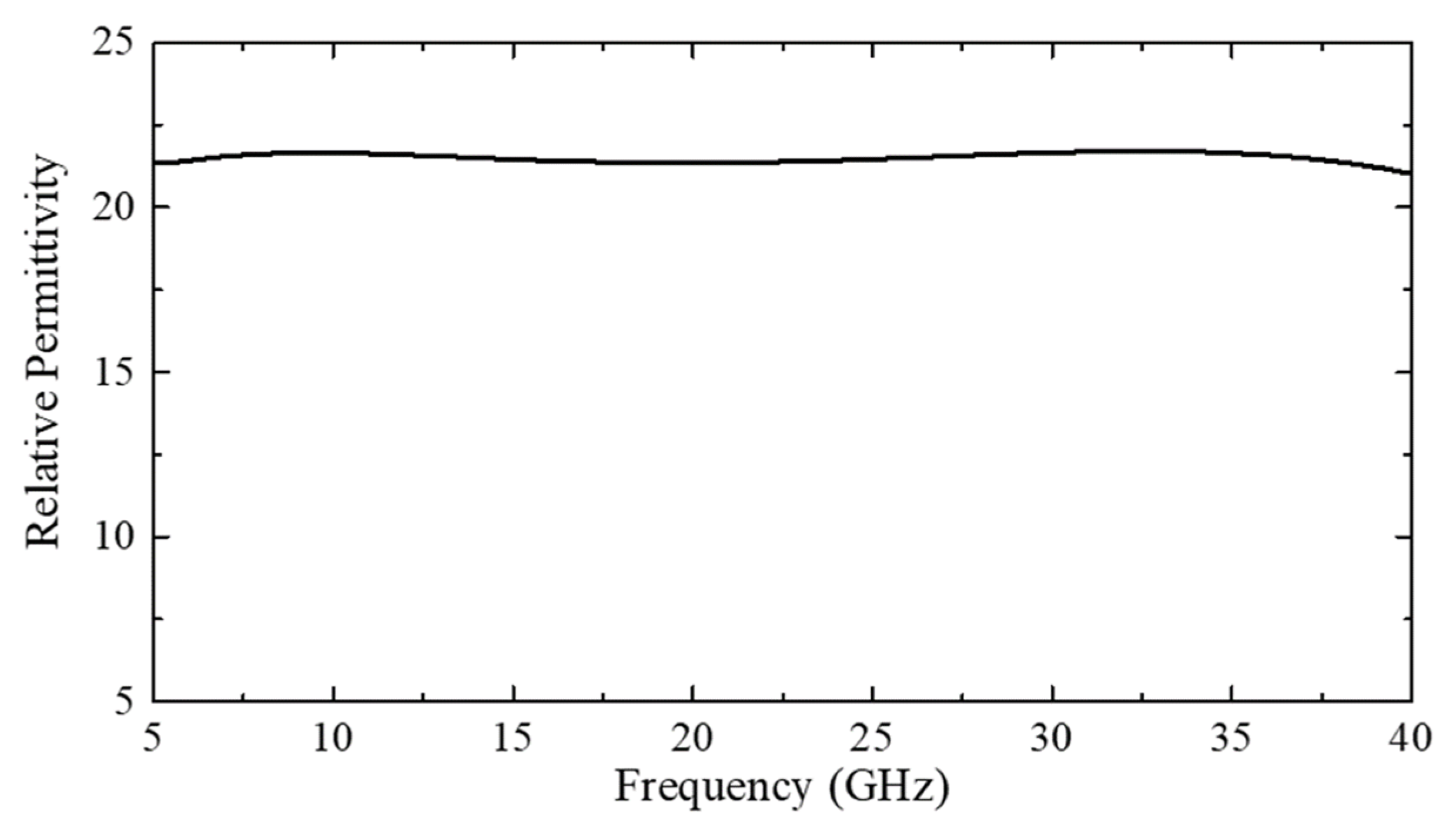



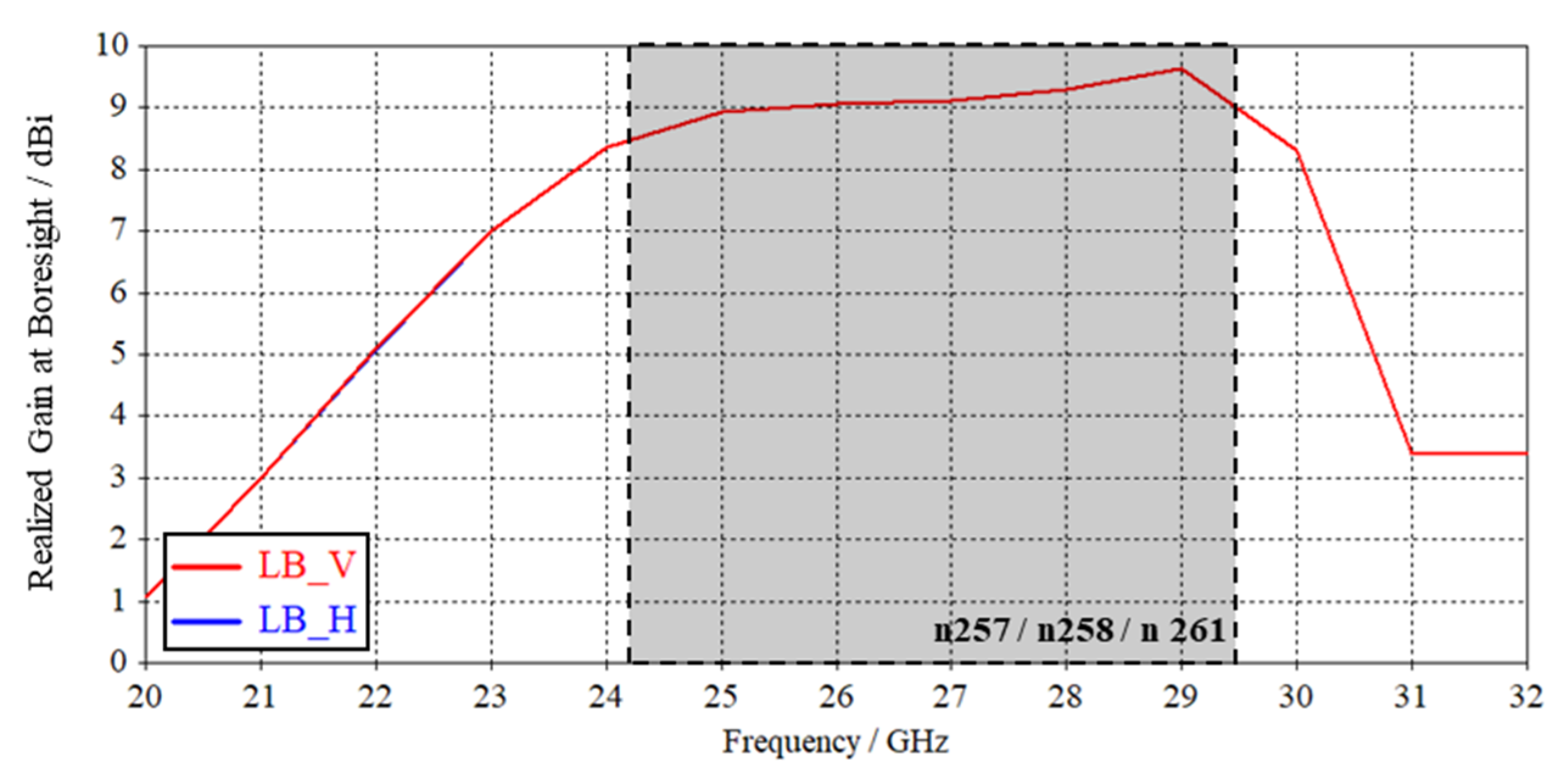


Disclaimer/Publisher’s Note: The statements, opinions and data contained in all publications are solely those of the individual author(s) and contributor(s) and not of MDPI and/or the editor(s). MDPI and/or the editor(s) disclaim responsibility for any injury to people or property resulting from any ideas, methods, instructions or products referred to in the content. |
© 2025 by the authors. Licensee MDPI, Basel, Switzerland. This article is an open access article distributed under the terms and conditions of the Creative Commons Attribution (CC BY) license (https://creativecommons.org/licenses/by/4.0/).
Share and Cite
An, S.Y.; Kim, B. Wideband Multi-Layered Dielectric Resonator Antenna with Small Form Factor for 5G Millimeter-Wave Mobile Applications. Electronics 2025, 14, 3756. https://doi.org/10.3390/electronics14193756
An SY, Kim B. Wideband Multi-Layered Dielectric Resonator Antenna with Small Form Factor for 5G Millimeter-Wave Mobile Applications. Electronics. 2025; 14(19):3756. https://doi.org/10.3390/electronics14193756
Chicago/Turabian StyleAn, Sung Yong, and Boumseock Kim. 2025. "Wideband Multi-Layered Dielectric Resonator Antenna with Small Form Factor for 5G Millimeter-Wave Mobile Applications" Electronics 14, no. 19: 3756. https://doi.org/10.3390/electronics14193756
APA StyleAn, S. Y., & Kim, B. (2025). Wideband Multi-Layered Dielectric Resonator Antenna with Small Form Factor for 5G Millimeter-Wave Mobile Applications. Electronics, 14(19), 3756. https://doi.org/10.3390/electronics14193756





